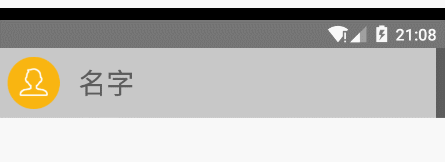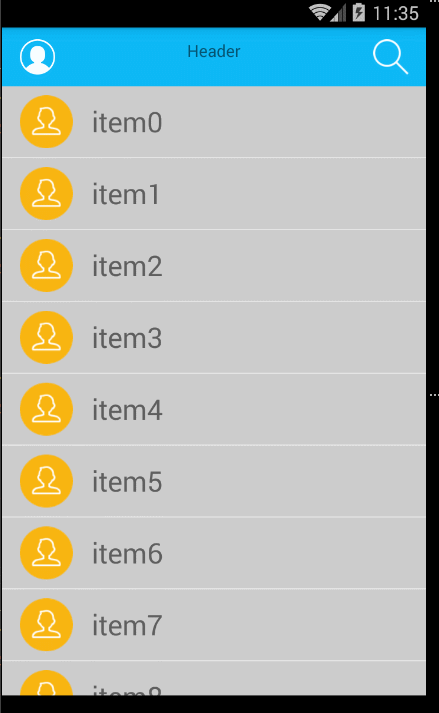前两天已经完成了高仿QQ6.0侧滑和优化,今天来看下侧滑删除的实现吧,如果有兴趣,可以去看下之前的两篇,仿QQ6.0侧滑之ViewDragHelper的使用(一)和高仿QQ6.0侧滑菜单之滑动优化(二),好了不多说,开始今天的内容了。
如果看过之前的两篇的话,想必今天的很好实现的,我们来分析一下哈,侧滑删除,布局也就是前面一个item,然后有两个隐藏的按钮(TextView也可以),然后我们可以向左侧滑动,然后显示出来,然后对delete(删除键)实现监听,就可以了哈。好了那就来看看代码怎么实现的吧。
首先和之前一样
自定义View,初始化ViewDragHelper:
package com.example.removesidepull;
import android.content.Context;
import android.support.v4.widget.ViewDragHelper;
import android.util.AttributeSet;
import android.view.MotionEvent;
import android.view.View;
import android.widget.FrameLayout;
/**
* Created by 若兰 on 2016/2/2.
* 一个懂得了编程乐趣的小白,希望自己
* 能够在这个道路上走的很远,也希望自己学习到的
* 知识可以帮助更多的人,分享就是学习的一种乐趣
public class SwipeLayout extends FrameLayout {
private ViewDragHelper mDragHelper;
public SwipeLayout(Context context) {
this(context, null);
}
public SwipeLayout(Context context, AttributeSet attrs) {
this(context, attrs, 0);
}
public SwipeLayout(Context context, AttributeSet attrs, int defStyleAttr) {
super(context, attrs, defStyleAttr);
//第一步 初始化ViewDragHelper
mDragHelper = ViewDragHelper.create(this, mCallback);
}
ViewDragHelper.Callback mCallback = new ViewDragHelper.Callback() {
@Override
public boolean tryCaptureView(View child, int pointerId) {
//返回true
return true;
}
};
}然后我们就要去处理拦截事件也就是重写一些onInterceptTouchEvent和onTouchEvent方法,默认是不拦截的:
/**
* 传递触摸事件
*
* @param ev
* @return
*/
@Override
public boolean onInterceptTouchEvent(MotionEvent ev) {
//交给ViewDragHelper判断是否去拦截事件
return mDragHelper.shouldInterceptTouchEvent(ev);
}
@Override
public boolean onTouchEvent(MotionEvent event) {
try {
mDragHelper.processTouchEvent(event);
} catch (Exception e) {
e.printStackTrace();
}
//返回true,这里表示去拦截事件
return true;
}然后我们去重写一下ViewDragHelper里面的clampViewPositionHorizontal方法:
@Override
public int clampViewPositionHorizontal(View child, int left, int dx) {
return left;
}好了这个时候,就已经可以实现滑动了,我们先来看下结果:

这里我们可以看到,已经可以滑动了,好了接下来的就是要处理滑动事件,去放置到正确的地方(call me 和删除刚开始不能见,还有只能左滑显示,右滑隐藏)。
好了,我们先获取两个View吧:
/**
* 当xml填充完毕的时候
*/
@Override
protected void onFinishInflate() {
super.onFinishInflate();
/**
* 后view
*/
mBackView = getChildAt(0);
/**
* 前view
*/
mFrontView = getChildAt(1);
}获取想要的宽和高:
/**
* 在这里获取宽和高
*
* @param w
* @param h
* @param oldw
* @param oldh
*/
@Override
protected void onSizeChanged(int w, int h, int oldw, int oldh) {
super.onSizeChanged(w, h, oldw, oldh);
/**
* 高度
*/
mHeight = mFrontView.getMeasuredHeight();
/**
* 宽度
*/
mWidth = mFrontView.getMeasuredWidth();
/**
* 移动距离
*/
mRange = mBackView.getMeasuredWidth();
}摆放这两个view的位置:
/**
* 摆放位置
* @param changed
* @param left
* @param top
* @param right
* @param bottom
*/
@Override
protected void onLayout(boolean changed, int left, int top, int right, int bottom) {
super.onLayout(changed, left, top, right, bottom);
layoutContent(false);
}
private void layoutContent(boolean isOpen) {
//摆放前view
Rect frontRect = computeFrontViewRect(isOpen);
mFrontView.layout(frontRect.left, frontRect.top, frontRect.right, frontRect.bottom);
//摆放后view
Rect backRect = computeBackViewRect(frontRect);
mBackView.layout(backRect.left,backRect.top,backRect.right,backRect.bottom);
//前置前view
bringChildToFront(mFrontView);
}
/**
* 我们可以把前view相当于一个矩形
*
* @param frontRect
* @return
*/
private Rect computeBackViewRect(Rect frontRect) {
int left = frontRect.right;
return new Rect(left, 0, left + mRange, 0 + mHeight);
}
private Rect computeFrontViewRect(boolean isOpen) {
int left = 0;
if (isOpen) {
left = -mRange;
}
return new Rect(left, 0, left + mWidth, 0 + mHeight);
}当然这个实现,只是可以拖拽了前view,因为我们没有把改变的dx传递下去,好了来实现拖拽前view的时候,后view也跟着出来(ViewDragHelper里面的方法):
/**
* 当view位置改变的时候
* @param changedView 改变的view
* @param left
* @param top
* @param dx x轴偏移量
* @param dy
*/
@Override
public void onViewPositionChanged(View changedView, int left, int top, int dx, int dy) {
super.onViewPositionChanged(changedView, left, top, dx, dy);
//传递事件,如果是拖拽的前view,
if (changedView == mFrontView){
//Offset this view's horizontal location by the specified amount of pixels.
//也就是说我的我的前view左滑了dx,那么我的后view也是左滑dx,右滑同理
mBackView.offsetLeftAndRight(dx);
} else if (changedView == mBackView){
//拖拽的是后view的话,前View的处理方式一样
mFrontView.offsetLeftAndRight(dx);
}
//兼容老版本
invalidate();
}好了这个时候我们来看下效果:

是不是发现了问题,就是我的前view想要的结果是不能右滑的(只允许左滑和返回),那么接下来就实现这个想要的结果吧。以下的代码是在clampViewPositionHorizontal()方法里面:
//在这里处理放置的逻辑拖拽的前view
if (child == mFrontView) {
if (left > 0) {
return 0;
} else if (left < -mRange) {
return -mRange;
}
}//拖拽的后view
else if (child == mBackView) {
if (left > mWidth) {
return mWidth;
} else if (left < mWidth - mRange) {
return mWidth - mRange;
}
}看下效果图:

好了,这个时候已经基本实现了,接下来实现以下滑动的距离和速度【判断是否打开和关闭:
/**
* 拖拽的view释放的时候
*
* @param releasedChild
* @param xvel
* @param yvel
*/
@Override
public void onViewReleased(View releasedChild, float xvel, float yvel) {
if (xvel == 0 && mFrontView.getLeft() < -mRange / 2.0f) {
open();
} else if (xvel < 0) {
open();
} else {
close();
}
}/**
* 关闭
*/
public void close() {
Utils.showToast(getContext(), "close");
layoutContent(false);
}
//打开
public void open() {
//Utils.showToast(getContext(), "open");
layoutContent(true);
}好了,接下来实现以下平滑的关闭和打开:
public void close() {
close(true);
}
/**
* 关闭
*
* @param isSmooth
*/
public void close(boolean isSmooth) {
int finalLeft = 0;
if (isSmooth) {
//开始动画 如果返回true表示没有完成动画
if (mDragHelper.smoothSlideViewTo(mFrontView, finalLeft, 0)) {
ViewCompat.postInvalidateOnAnimation(this);
}
} else {
layoutContent(false);
}
}
public void open() {
open(true);
}
/**
* 打开
*
* @param isSmooth
*/
public void open(boolean isSmooth) {
int finalLeft = -mRange;
if (isSmooth) {
//开始动画
if (mDragHelper.smoothSlideViewTo(mFrontView, finalLeft, 0)) {
ViewCompat.postInvalidateOnAnimation(this);
}
} else {
layoutContent(true);
}
}
/**
* 持续动画
*/
@Override
public void computeScroll() {
super.computeScroll();
//这个是固定的
if (mDragHelper.continueSettling(true)) {
ViewCompat.postInvalidateOnAnimation(this);
}
}我们看下最终的效果吧:

好了,在这里我们加上一些回调,以方便外部使用的时候可以回调:
/**
* 默认状态是关闭
*/
private Status status = Status.Close;
private OnSwipeLayoutListener swipeLayoutListener;
public Status getStatus() {
return status;
}
public void setStatus(Status status) {
this.status = status;
}
public OnSwipeLayoutListener getSwipeLayoutListener() {
return swipeLayoutListener;
}
public void setSwipeLayoutListener(OnSwipeLayoutListener swipeLayoutListener) {
this.swipeLayoutListener = swipeLayoutListener;
}
/**
* 定义三种状态
*/
public enum Status {
Close, Open, Draging
}
/**
* 定义回调接口 这个在我们
*/
public interface OnSwipeLayoutListener {
/**
* 关闭
*
* @param mSwipeLayout
*/
void onClose(SwipeLayout mSwipeLayout);
/**
* 打开
*
* @param mSwipeLayout
*/
void onOpen(SwipeLayout mSwipeLayout);
/**
* 绘制
*
* @param mSwipeLayout
*/
void onDraging(SwipeLayout mSwipeLayout);
/**
* 要去关闭
*/
void onStartClose(SwipeLayout mSwipeLayout);
/**
* 要去开启
*/
void onStartOpen(SwipeLayout mSwipeLayout);
}dispatchSwipeEvent()方法(在onViewPositionChanged()方法中调用)
protected void dispatchSwipeEvent() {
//判断是否为空
if (swipeLayoutListener != null) {
swipeLayoutListener.onDraging(this);
}
// 记录上一次的状态
Status preStatus = status;
// 更新当前状态
status = updateStatus();
if (preStatus != status && swipeLayoutListener != null) {
if (status == Status.Close) {
swipeLayoutListener.onClose(this);
} else if (status == Status.Open) {
swipeLayoutListener.onOpen(this);
} else if (status == Status.Draging) {
if (preStatus == Status.Close) {
swipeLayoutListener.onStartOpen(this);
} else if (preStatus == Status.Open) {
swipeLayoutListener.onStartClose(this);
}
}
}
}updateStatus()方法:
/**
* 更新状态
*
* @return
*/
private Status updateStatus() {
//得到前view的左边位置
int left = mFrontView.getLeft();
if (left == 0) {
//如果位置是0,就是关闭状态
return Status.Close;
} else if (left == -mRange) {
//如果左侧边距是后view的宽度的负值,状态为开
return Status.Open;
}
//其他状态就是拖拽
return Status.Draging;
}好了,事件基本上已经实现完毕了,这个侧拉删除的我会更新至我的项目中,
项目地址:高仿QQ6.0界面 https://github.com/wuyinlei/QQ6.0,github上面的最终现在效果:




















